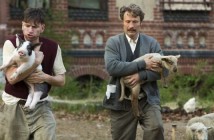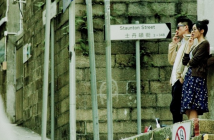
Editor’s Notes: The following review is part of our coverage of the 2016 Hot Docs Film Festival. For more information visit hotdocs.ca and follow Hot Docs on Twitter at @hotdocs.
In the 1980s, Director Livia Ungur was a young child during communist rule in Romania where most of the citizens were exposed to very little western fare. One of the shows that did make it there was the long running American television soap opera called Dallas. Starring Patrick Duffy, Linda Grey, Larry Hagman and others, the show captivated its audiences with its allure of glamour, intrigue, and corruption.
Ungur immigrated to the U.S. in 2004 and met and married fellow artist Sherng-Lee Huang. Together they wrote, produced, and directed Hotel Dallas, a documentary slash fiction film. Documentaries already have a veil of fiction upon them, since there is a filter of rendering in order to make a cinematic essay of a subject. In this film, Ungur and Huang create a surreal retelling of Ungur’s personal history involving the political upheavals of her country combined with the philosophical search of national identity, in the surreal frame of the show Dallas.
Ungur plays a younger version of herself travelling back to Romania to visit her father who plays a JR type corrupt sunflower oil tycoon. He has rebuilt the Dallas ranch and the Eiffel Tower on his property and is put in jail for his crimes against his country. This all leads Ungur to journey with Mr. Here (played by Patrick Duffy) to a sculpture by Constantin Brancusi called “Endless Column.” The artwork symbolizes her path from cultural oppression to artistic freedom. Dreamy imagery of Romania’s past is reenacted by children and provides an absurd anchoring thread for this art house menagerie of a film.
While the film can feel a bit disjointed in parts, however, its avant-garde rendering is a unique take on artistic personal statement made as film. Ungur and Huang take the camera to giant expansive sets in Romania: a graveyard called “Laughing Cemetery;” Ungur’s mother’s house where Ungur becomes a miniature version of herself before her travels; and to her extended family’s home where philosophers talk in poetic verse about the meaning of labor versus art. There’s a sort of Matthew Barney feel to the film, not so much in terms of artistic or viewer endurance, but rather a conscious pondering of an artist arguing with her home nation’s past in her head and what that means to her future work.
Patrick Duffy’s portrayal as Mr. Here is as an observer and someone along for the ride. There is a small backstory where he is resurrected in the film as a narrative voice. It is also a layered a play upon on his odd return from the dead in Dallas, that had the show rewrite sixty episodes as a dream.
Hotel Dallas is an interesting example of how artists portray their reality in documentary format, but expound upon it utilizing a plethora of artistic methods at their disposal. Ungur and Huang create a film that is a feast for the eyes (Romania is a lush and gorgeous country), that is aesthetically expressionistic, and ultimately a great reminder that there is still so much more dimensions to explore within the documentary medium.
Ungur and Huang create a film that is a feast for the eyes (Romania is a lush and gorgeous country), that is aesthetically expressionistic, and ultimately a great reminder that there is still so much more dimensions to explore within the documentary medium.



